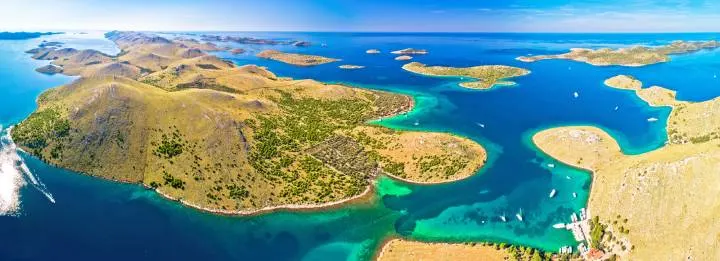Planning your next sailing holiday in Croatia? Then, sailing Kornati islands will be an unforgettable holiday. Here are our top 5 reasons to do a yacht charter in the Kornati Islands.
Made up of 147 islands, the Kornati Islands are the densest archipelago in the Mediterranean. With beautiful lagoons, winding channels and vast sea, sailing in Kornati is an amazing experience. On land you’ll find striking limestone eroded by nature, speckled with beautiful greenery, like wild herbs, pine, and olive trees.
So note-worthy visits are the islands of Levrnaka, Žut, and Mana. Levrnaka is known for the nice sandy Lojena beach where you can sunbathe in peace. Žut is known for its translucent waters and craggy coastline. Mana is known for the “ruins” built for the 1959 movie, “As the Sea Rages” or “Raubfischer in Hellas.”, which is situated atop it’s striking cliff.
While sailing Kornati, you can also visit the two national parks that are home to calm, clear, deep blue water and a plethora of beaches to explore. Go diving at the island of Kaprije, where you’ll find sunken shipwrecks that attract professional divers worldwide.
Also onshore, in Telascica Bay on the island of Dugi Otok, you’ll find breathtaking cliffs that soar 200m above sea level. These cliffs are home to a great variety of birds, including the Peregrine Falcon and Eleanor’s Falcon. Also on Dugi Otok, you can visit the Mir Salt Lake where the native Kajman eel lives.

One of the biggest attractions of sailing Kornati is the unparalleled serenity, The Kornati is mostly uninhabited; aside from a handful of seasonal cottages, there are no big developments, no massive crowds to contend with. Due to its remoteness, even in the middle of the sailing season, you may only encounter a few other people.
Considered one of Europe’s last wildernesses, you can be sure that you will enjoy peace and quiet during your yacht charter in Kornati. Perfect for people looking to escape the hustle and bustle of daily life, Kornati islands sailing allows you to disconnect from civilization and reconnect with nature and yourself.
Croatia is often hailed as a great spot for all sailors, no matter your experience level, first time sailor or not, and Kornati is certainly no exception. The Adriatic sea is known for it’s beautiful, calm and clear, blue waters. With light winds that are rarely greater than a Force 4, sailing Kornati is a very relaxing experience. In the early and late season, you may encounter the “Bora” wind, which is a bit stronger, but it is rare outside the winter months. The summer season, between April and September, will provide mostly sunny days with temperatures consistently in the 20s and 30s. With perfect weather, sailing will be a breeze!
Because of the many islands and islets in the Kornati archipelago, a Kornati Islands sailing itinerary can be planned with short cruising distances. Kornati Islands sailing also offers many protected anchorages for easy mooring.
For more experienced sailors, sailing Kornati is ideal for a bareboat charter and for those who are a little greener, perhaps consider a yacht charter in Kornati with a skipper. Yacht4Less can help you hire the perfect guide for your holidays, so you can rest easy while they sail you away.
The Kornati islands are also very conveniently situated, just about 15-30 minutes from the Zadar airport, so whether you’re traveling with young children, older folks, or a big group of friends, getting to the base will be quick and easy. Zadar is also a well connected international airport, so no matter where you start your journey you should be able to get to your yacht charter in Kornati with ease.
The sailing and the scenery may be incredible, but Kornati also has a fascinating history. While the islands are uninhabited now, they weren’t always. While sailing Kornati you’ll have the opportunity to uncover the ancient neolithic history of the archipelago. You can learn about the pirate attacks, local economies, and some prehistoric architecture.
Go ashore and explore the remains of stone walls, olive orchards, forts, churches, and sea-salt refineries. The island of Katina has ruins from a residence dating back to roman times. On Dugi island, you can walk to a lighthouse built in 1849, which is the tallest lighthouse in the Adriatic at 42m tall.
While the Kornati Islands are not habitable full time, that doesn’t mean you can’t experience Croatian Culture while sailing Kornati. You’ll enjoy discovering the little summer villages and hidden gem restaurants nestled in the islands.
On the island of Dugi, the largest Kornati island, you’ll find a fishing village called Sali. Here you’ll find a supermarket, a bakery and some restaurants to try out. You can also rent cars, bikes, and motorcycles to explore the rest of the island.
Another great place to enjoy fresh caught seafood is at the restaurants: Mare and Konoba Suha Punta on Kornat Island. Famous for authentic croatian food, the Kod Kate restaurant in Kaprije is worth a visit! Also one of Kornati’s restaurants has a Michelin rating; enjoy the modern-traditional fusion at KONOBA BOBA on the island of Murter.
Dreaming of sailing Kornati now? Learn more about a yacht charter in Kornati from our charter consultants.